Day 2, I Should Have Taken the Stairs
Back on Ave Rachel, I head back to Cafe Maestro and ask them if it’s too late for lunch. It is. I turn left to get back on Clichy and turn left again just after the Moulin Rouge.
 Up Rue Lépic, a slight hill, I pass 1- and 2-star hotels on both sides. Rue Lépic becomes rue Tholoze III, and people begin to bustle as I reach the end of the street near the top of the hill. At the top of the hill there’s another windmill, called the Moulin du Radet, looking ancient and broken down, though I learn from the book that it’s a recreation of an original. Bookstores and cafes are all around, and there are tables on a grassy field in front of the old-looking moulin. Their lunch is closed as well, though people still sit in most of the tables.
Up Rue Lépic, a slight hill, I pass 1- and 2-star hotels on both sides. Rue Lépic becomes rue Tholoze III, and people begin to bustle as I reach the end of the street near the top of the hill. At the top of the hill there’s another windmill, called the Moulin du Radet, looking ancient and broken down, though I learn from the book that it’s a recreation of an original. Bookstores and cafes are all around, and there are tables on a grassy field in front of the old-looking moulin. Their lunch is closed as well, though people still sit in most of the tables.
I turn right at the moulin and head down rue Lépic (I’ve rejoined it), then take a left and a quick right onto rue Norvins. Here there’s a great little sculpture called Le Passe-Muraille, where a man in bronze appears to be walking out from the wall in the square. It’s taken from a short story written by the square’s namesake, Marcel Ayme. Further up rue Norvins I re-enter the tourist haven, with souvenir shops and expensive cafes everywhere. I spot a small-looking boulangerie where I pick up a sandwich with my remaining cash, but can’t afford a drink or a sweet. I choose tuna and I eat it as I walk. The mayonnaise in this country is the best I’ve ever had, and I don’t think that should be surprising.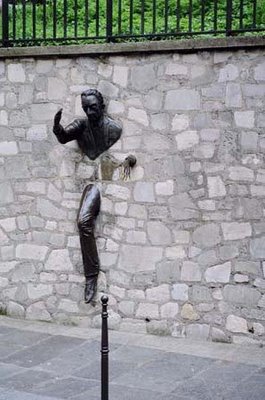
Near here I see a small sign for an Internet Cafe. It also appears to be a Lebanese restaurant. Too bad I just ate. I buy a Euro’s worth of time and catch up on emails. My interaction with the proprietor goes smoothly and I am feeling more confident in my French, even though my best interactions have come with speaking to those whose native language is neither French nor English.
On rue Norvins, I can see Sacre Coeur, and I walk toward it. But another glance tells me I’ve missed a turn: there’s a vineyard nearby, in the middle of the city, and I decide I must see it. Back onto rue des Saules. I see the Maison Rose the book refers to, but I’ve already had my lunch, as it were. Down a rather steep hill, there it is on my right: a vineyard. Steppes of green grass and wire surround and separate little brown stumps of grapevines, separated from me by chain-link fences. I try to take pictures from several angles but I can’t get much. I look around, and am surprised that the only people anywhere nearby are French. One block away there are a thousand Americans and Germans looking at a church, but nobody seems to care about a lovingly tended vineyard in the least likely of places.
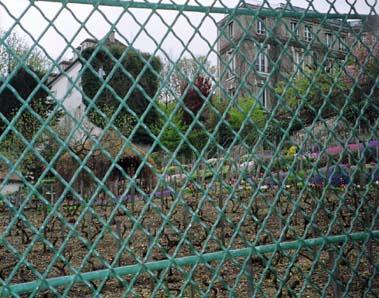 Down at the corner, I turn around and look back up. It can’t be more than an acre, this magical little place; I begin to look for any hint of a way to get some of this wine. I see no obvious doorways or signage denoting opening hours. In the book they imply that they only make this once per year and they throw a big gala to celebrate it. I guess they drink it all at once during that.
Down at the corner, I turn around and look back up. It can’t be more than an acre, this magical little place; I begin to look for any hint of a way to get some of this wine. I see no obvious doorways or signage denoting opening hours. In the book they imply that they only make this once per year and they throw a big gala to celebrate it. I guess they drink it all at once during that.
Turning right one street earlier than the book says (one street before St Vincent), I go around the vineyard to rejoin the quest for Sacre Coeur. On the right near the corner of rue DuMont III, there’s a jardin sauvage, a natural growth area that looks like a small jungle in the middle of the city. I’m tempted to go into it and hang around, but it’s getting to be 3:30 now, and I need to get moving. As I walk up the hill to rejoin the tourists I wonder not only how two small pockets of vegetation could live, not only so close to the center of this city, but so close to each other. The lovingly tended vineyard seems to suffer no ill effects from being so close to the savage garden.
Amazing.
3:30pm
A quick left and right, and I see it: Sacre Coeur. Impossibly white. The book says this building secretes calcium whenever it rains, bleaching itself naturally to ensure the color lasts forever, or until it dissolves from the secretion. The basilica appears out from behind a building, towering over me as it’s towered over Paris since the late 19th century. To me there’s something vaguely Russian about it somehow, I think because there is the one enormous dome, surrounded by many smaller ones, like a mother surrounded by her children. The domes are all ringed in what looks like tulip petals pointed down, all white and very small. Using my binoculars, I can see every scratch of stone up at the top, each line curved exactly as the last, perfect in its symmetry.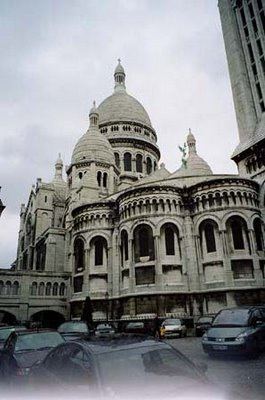
There’s a park next to me, and a toilette. It looks like I’d have to go through a bit to use it, so I decide to wait. Walking around the left side of the church, I begin to see what kind of view this hill affords. I think about the scene in Amélie, where she leads him on a scavenger hunt of sorts to give him back his photo-album. Did that scene take place here? I would find out later that I was right. Children are everywhere, and I hear English, German, Dutch, Arabic, Hindu, and yes, French. Men are holding their children in place to look through the telescopes at the view of Paris. I go down to where the railing overlooks the city, and I turn around. The basilica faces me now, and its whiteness makes me forget to breathe. With the binoculars I examine every detail of the dome, and try to see what colors the tourists are wearing in that middle ring. Then I turn to face the city. Montparnasse tower, Notre Dame, a minaret, the dome at Les Invalides, but I can’t see the Eiffel tower. I ask a young woman next to me where the tower is, and she points to it, all the way to my right behind a building. I thank her and study it.
I walk around to the other side of the church, trying to orient myself in order to continue the walk. Do I want to go up the dome? It costs money, even though the book says it won't. I don’t know if they take credit cards. I’m tired as hell, because this walk has taken much longer than I anticipated. There’s a statue on the wall to my right, whiter than the dome, probably whiter than anything I’ve seen in Paris. There’s a box with a slot in the top at the statue’s feet. My Paris Las Vegas experience kicks in: this is a performer. I look around and people are walking by this man with barely even a glance. I put seventy-five American cents into his box and turn around. As I do, I see about two dozen people stop and stare. I hear gasps. I turn around and, as expected, the statue is smiling and waving to me. I smile and wave back. Other people approach him and I hear the tinkling of coins as I head back down the hill.
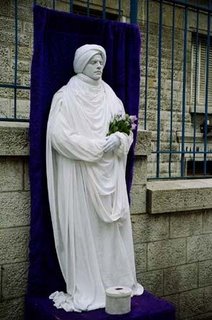 To the left and to the right people are going down what appear to be three hundred steps. Blisters are forming on my feet and my calf muscles are screaming at me. Two large machines full of people move up and down, allowing lazy people like me to circumvent the stairs. It's called the Funiculaire de Montmartre. All it costs is a single Metro ticket? Sold!
To the left and to the right people are going down what appear to be three hundred steps. Blisters are forming on my feet and my calf muscles are screaming at me. Two large machines full of people move up and down, allowing lazy people like me to circumvent the stairs. It's called the Funiculaire de Montmartre. All it costs is a single Metro ticket? Sold!
I look on the tour book map and realize it has me going back onto the streets to finish up at Place des Abbesses, and I immediately decide to abandon the walk. I’ve seen some amazing stuff already. As I get onto the Funiculaire, I see a family of people who look Middle-Eastern, a few Frenchmen, and 3 men speaking Greek.
The lumbering machine begins its descent and I’m afforded a view of the park nearby. Children run around and climb all over their parents. Women take pictures of their families as--SHIT! I’m nearly thrown to the floor as the tram stops dead. People gasp as most of us tumble to the floor. After it's stopped I look around, recovering from the shock and trying to figure out why this would have happened. Across the square, the other tram is running just fine.
Labels: paris
























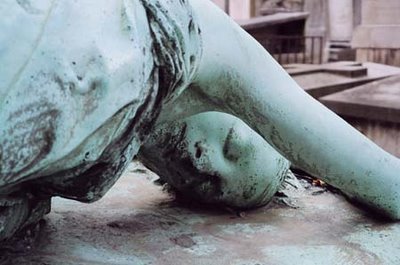

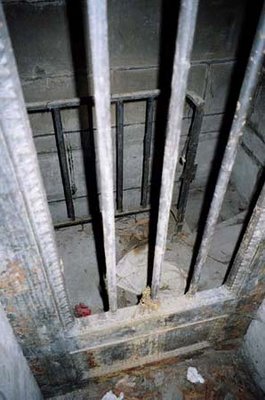




 There is a pink 3-ring binder laying on the grave. Without touching it I read the front cover. It’s from a documentary filmmaker, gathering remembrances from people who visit Truffaut’s grave. He wants people to write notes telling Truffaut what they appreciate about him, so I do.
There is a pink 3-ring binder laying on the grave. Without touching it I read the front cover. It’s from a documentary filmmaker, gathering remembrances from people who visit Truffaut’s grave. He wants people to write notes telling Truffaut what they appreciate about him, so I do.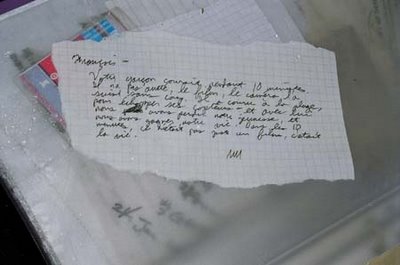

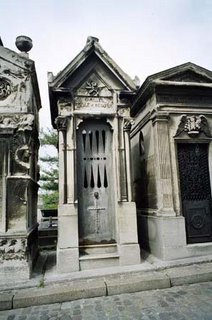

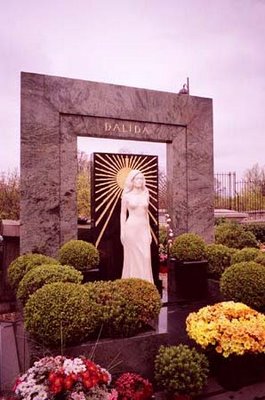

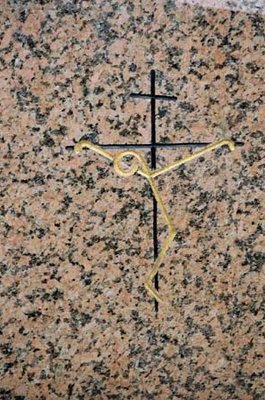
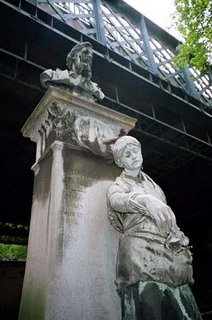

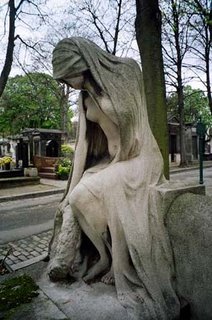


 Truffaut is also buried here somewhere. The only film of his I’ve seen is the 400 Blows, but that's one of those films that lingers and takes over and crawls around in my head. I can’t leave without seeing him.
Truffaut is also buried here somewhere. The only film of his I’ve seen is the 400 Blows, but that's one of those films that lingers and takes over and crawls around in my head. I can’t leave without seeing him.